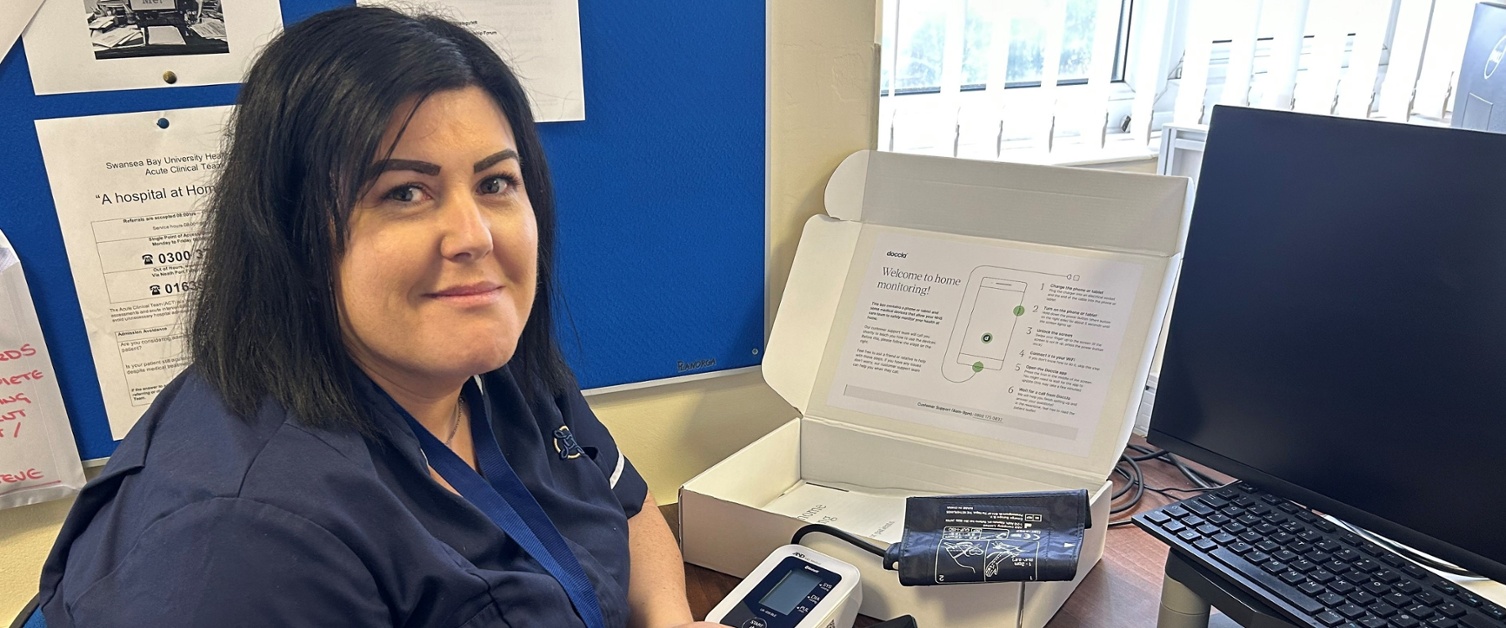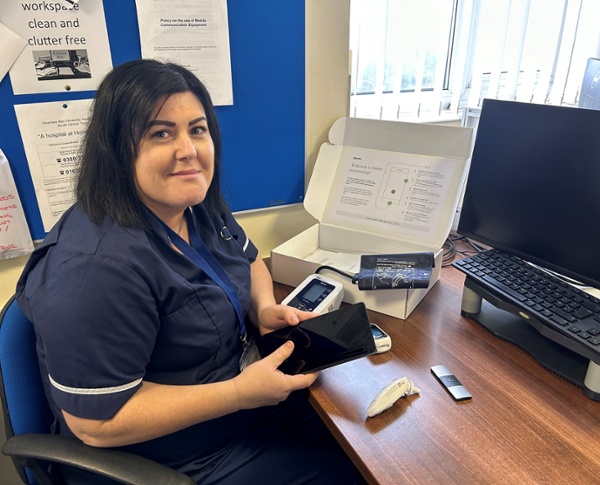Patients can use monitoring devices from home as part of pilot project

Patients will be able to monitor their vital signs such as blood pressure, pulse and temperature through devices at home to help save time and resources.
The pilot project, which allows results to be logged on a smartphone or tablet via Bluetooth and then sent to clinicians, is being rolled out in Swansea Bay’s virtual wards.
The health board is the first in Wales to use this technology within its virtual ward service.
It provides wraparound support in the community to people with complex health and social needs.
Rather than a ward being made up of hospital beds, the patients’ own beds become part of a virtual ward, meaning they still receive face-to-face care but in their own homes instead of a hospital.

Pictured: Cheryl Griffiths, Afan Cluster’s virtual ward clinical manager, with the new kit.
A multi-disciplinary team made up of health and care professionals, such as doctors, nurses, pharmacists and therapists, discuss how to plan and manage each patient’s care, ensuring face-to-face assessment and intervention is carried out.
The home device project is in partnership with Technology Enabled Care Cymru, which is funded by Welsh Government.
It is hoped to promote greater patient engagement with their health and care needs and enable staff to see more patients by creating efficiencies in time relating to travel and follow-ups.
More regular patient observations will also mean clinicians have a wider range of readings to refer to when making key decisions around their medication and care.
The project will explore the effectiveness and impact of the devices in delivering better patient care and form a framework to develop nationwide policy on the use, and rollout, of the technology.
Emily Davies, the health board’s Acting Associate Director of Nursing, said: “Healthcare staff often need regular blood pressure, pulse and temperature readings for patients on our virtual wards in order to make decisions regarding best treatment options and medication changes.
“That process can be quite time consuming for the team, especially as parts of Swansea Bay are quite rural and cover large geographical areas.
“So, staff may spend a lot of time driving to see a patient to get their observations.
“The more regularly we get a patient’s observations, the more effectively we can monitor and adjust their medication and care, if needed.”
Patients who are identified as being able to monitor their own readings will receive the devices and kit needed, which are funded by the Welsh Government.
They are given instructions on how to set them up and use them.
Once the results are logged via the device, clinicians will be able to access them to determine if any support or intervention is needed relating to their health conditions.
If their readings are outside of the normal parameters, they will be marked with a red flag and clinicians will also receive an email to inform them.
Emily added: “The machines link via Bluetooth to the device they are given, so all they have to do is put the equipment on and press go.
“Once it’s taken their reading it goes to an app on the device which then comes up on screen for the clinicians to see.
“The same applies to pulse and oxygen saturations, which they put on their finger, and then temperature via a Bluetooth thermometer. We will also look at weight for patients with heart failure.”

It won’t be appropriate for all patients to take part but the pilot will help to develop guidance on who can gain the most from the new approach.
“It is about identifying those who are able to engage with what’s required and if they’re not, perhaps they have a family member or carer who can help them,” Emily said.
“We appreciate it won’t be appropriate for all patients but our aim is to identify the right cohorts of patients that will benefit the most from this type of technology, such as those with specific chronic conditions.
“From that we could look at developing a checklist to help make a decision on whether individual patients are appropriate for this type of monitoring.”
Pictured: The kit that will be given to patients.
The devices will also benefit the hospital based virtual ward in-reach team, which identifies hospital patients suitable for earlier safe discharge, helping to free up beds and support patients to return home quicker.
When virtual ward patients leave hospital to be cared for at home instead, clinicians can continue to monitor them via the devices if needed.
This can provide further reassurance to hospital staff that the patient can be discharged safely to their home.
Emily said: “We hope it will help to give reassurance to hospital staff when it comes to discharging patients, as we can link the patients up with the monitoring devices and continue to monitor them from the comfort of their own home.
“It could also help to give reassurance to patients and their families as they are given the kit to take home.
“The virtual ward team are really excited for this project and very proud to have the opportunity to inform the development of a national policy for an innovative development in patient care.”
Dr Anjula Mehta, the health board’s Acting Executive Medical Director, said: “This is what transformative healthcare is all about.
“We recognised we could be doing more to promote quicker and safer patient recovery through assisted technology.
“It gives Swansea Bay the opportunity to become the pacesetters of such digital healthcare advancements to improve the quality of care for our patients and support the care closer to home initiative.
“We are very proud of the collaborative work between the health board and TEC Cymru and look forward to sharing the outcomes.”
Rydym yn croesawu gohebiaeth a galwadau ffôn yn y Gymraeg neu'r Saesneg. Atebir gohebiaeth Gymraeg yn y Gymraeg, ac ni fydd hyn yn arwain at oedi. Mae’r dudalen hon ar gael yn Gymraeg drwy bwyso’r botwm ar y dde ar frig y dudalen.
We welcome correspondence and telephone calls in Welsh or English. Welsh language correspondence will be replied to in Welsh, and this will not lead to a delay. This page is available in Welsh by clicking ‘Cymraeg’ at the top right of this page.